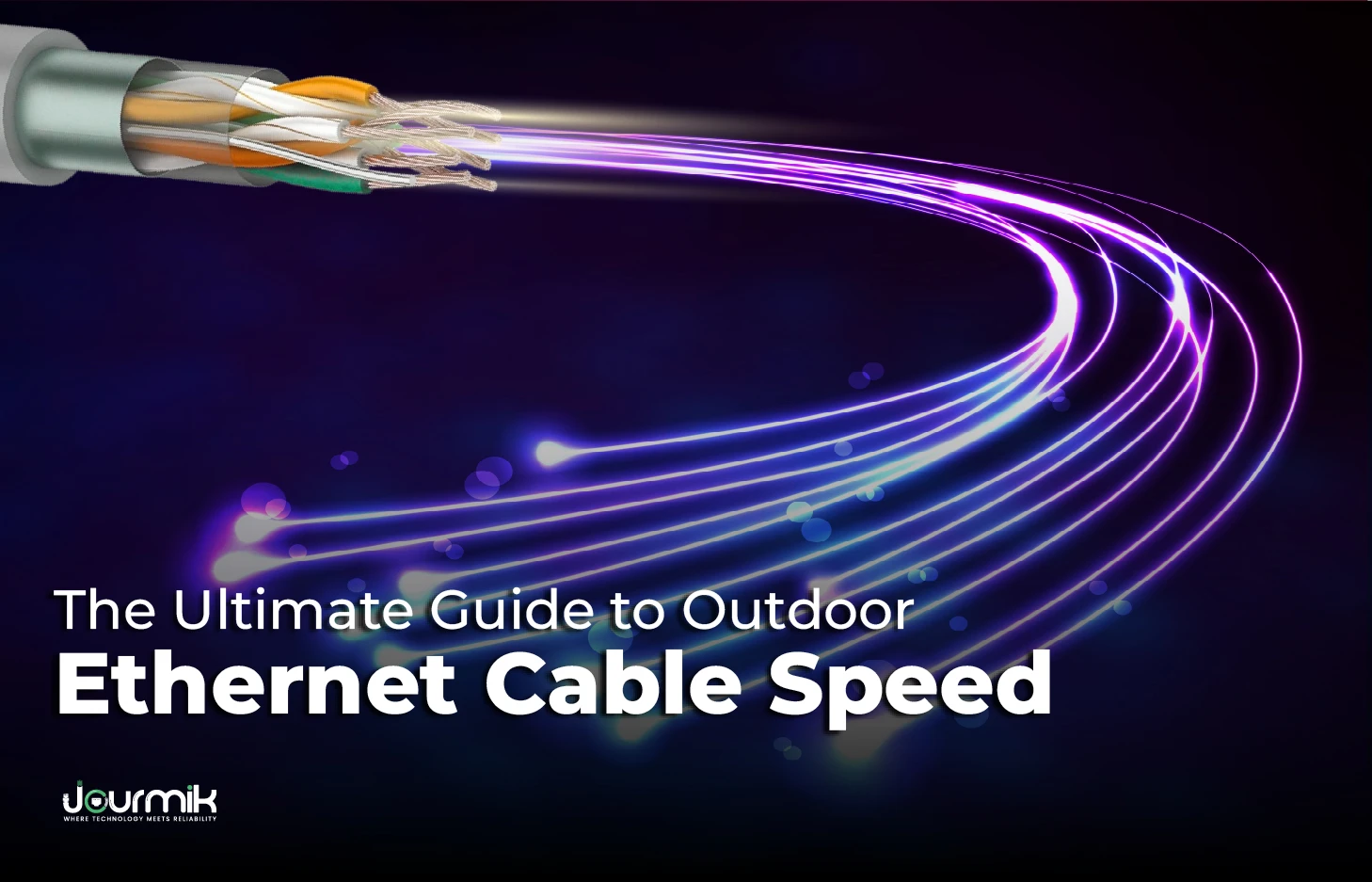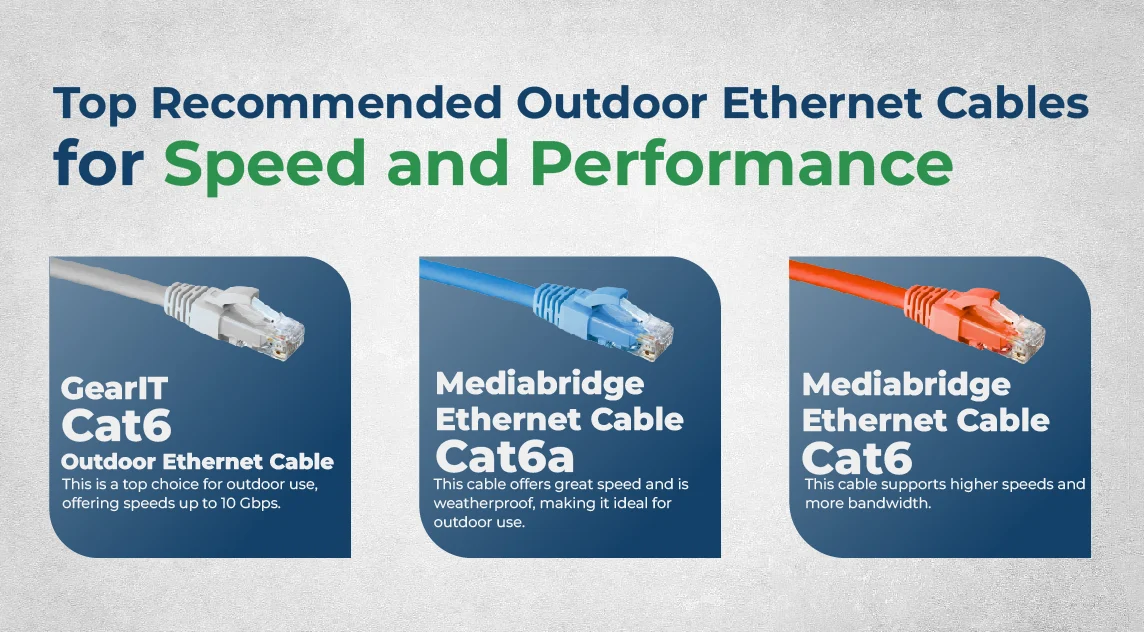The Ultimate Guide to Outdoor Ethernet Cable Speed

Have you ever experienced your internet speed dropping out of nowhere? You might have been on a video call, gaming, or streaming a movie when your connection suddenly slowed or cut out. If you’re using an outdoor Ethernet cable that’s not up to the task, this can happen more often than you’d like.
Choosing the right outdoor Ethernet cable is crucial for keeping your internet fast and reliable. Many people unknowingly pick the wrong type of cable, which can lead to slower speeds or even complete connection failures. This guide explains why choosing the right outdoor Ethernet cable is important. Let’s dive into the details and ensure your internet stays fast and reliable, no matter where you are.
Keep reading to discover which Ethernet cable is perfect for your needs!
Table of Contents
What is an Outdoor Ethernet Cable?
An outdoor Ethernet cable is specifically designed to work outside. It differs from indoor cables because it’s built to resist harsh weather, UV rays, moisture, and physical wear. These cables are made with tough materials to keep them safe from the elements so they can deliver a reliable internet connection no matter what the weather throws at them.
Indoor cables, on the other hand, aren’t made for this kind of protection. They can break down quickly when exposed to sunlight or rain. Outdoor Ethernet cables are built to work in any weather. So, they are the best option for outdoor network setups.
Role of Ethernet Cables in High-Speed Connectivity
Imagine trying to stream a movie in 4K or play an online game, and your internet keeps buffering or lagging. It’s frustrating, right? Speed is everything when it comes to using the internet, especially for activities like gaming, streaming, or video conferencing.
The right Ethernet cable ensures your internet is fast and reliable, even when you’re outdoors. Outdoor Ethernet cables, such as Cat6 or Cat6a, offer fast connections. They help with smooth video calls, gaming, and downloading big files. For example, a Cat6 outdoor Ethernet cable can deliver speeds up to 10 Gbps over short distances, which is more than enough for most internet activities.
How to Choose the Right Outdoor Ethernet Cable for Your Needs
There are a few things to keep in mind when picking an outdoor Ethernet cable to make sure it meets your speed and durability needs:
- Cable Category (Cat5e, Cat6, Cat6a, Cat7): An Ethernet cable’s category affects its data transmission speed. Cat5e cables can handle speeds up to 1 Gbps, while Cat6 and CAT6a cables can handle speeds up to 10 Gbps. If you need more speed, Cat7 cables are even better, supporting higher speeds and frequencies.
- Shielding: Some outdoor cables have extra protection. This helps block interference from electrical devices or power lines. If you live in an area with a lot of electronic equipment or high-voltage power lines nearby, a shielded cable (STP) is a good choice. Unshielded cables (UTP) are fine for areas with less interference.
- Weather Resistance: Outdoor cables need to be tough enough to handle the weather. Look for cables that have UV-resistant jackets to protect them from the sun’s harsh rays. Additionally, water-resistant cables will keep working in the rain or snow. Some cables are even rated for direct burial if you plan to bury them underground.
Cable Length and Its Impact on Speed
One important thing to know about Ethernet cables is that their length can affect your internet speed. The longer the cable, the weaker the signal becomes as it travels. For example, a long cable might cause slower speeds or even drop the connection entirely.
For most home and office setups, cables that are 100ft to 200ft long should be fine. However, if you need to run a cable further, consider using a higher-quality cable like Cat6a to maintain the best speed.
How Outdoor Conditions Affect Your Ethernet Cable
Outdoor cables face many challenges, from UV rays to rain, snow, and extreme temperatures. These weather conditions can quickly break down indoor cables, so outdoor Ethernet cables need to be extra tough.
Make sure you pick a cable with a durable, weather-resistant jacket. Some cables are rated for direct burial. This means they can be buried underground safely. They won’t get damaged by moisture or dirt. This extra layer of protection will help your cable last longer and keep your internet running smoothly.
Best Installation Practices:
Even the best outdoor Ethernet cable can fail if it’s not installed right. Here are some simple tips to ensure you get the most out of your cable:
- Use Conduit for Extra Protection: Run your cable through a protective conduit. This keeps it safe from damage, animals, and the weather. This is especially important if you’re burying the cable underground or leaving it exposed outside.
- Avoid Interference: Try to keep your Ethernet cables away from sources of electrical interference, like power lines or heavy machinery. Shielded cables (STP) help reduce interference, but proper placement can also make a big difference.
- Proper Cable Management: Keep your cables organized and secure. Don’t let them hang loosely or get tangled. This helps prevent wear and tear, keeping the cable in good condition for longer.
Top Recommended Outdoor Ethernet Cables for Speed and Performance
Here are a few outdoor Ethernet cables that stand out for their speed, durability, and overall performance:
- GearIT Cat6 Outdoor Ethernet Cable: This is a top choice for outdoor use, offering speeds up to 10 Gbps. It’s durable, weatherproof, and built to handle tough conditions.
- Mediabridge Ethernet Cable (Cat6): This cable offers great speed and is weatherproof, making it ideal for outdoor use. It’s a great option if you need a stable, high-speed connection.
- Mediabridge Ethernet Cable (Cat6a): This cable supports higher speeds and more bandwidth. It’s perfect for gaming or transferring large data.

These cables are perfect for anyone who needs a fast, reliable connection outside. They are designed to last and perform well even in difficult conditions.
Conclusion
Speed and reliability are key when choosing an outdoor Ethernet cable. For streaming, gaming, or working remotely, you need a reliable cable. It should perform well, even in bad weather. By considering factors like cable category, shielding, weather resistance, and proper installation, you can ensure your outdoor setup runs smoothly and your internet stays fast.
Ready to upgrade your outdoor network? Check out our selection of high-performance outdoor Ethernet cables at Jourmik.com and start enjoying faster, more reliable connectivity today!
Frequently Asked Questions
What is an outdoor Ethernet cable?
An outdoor Ethernet cable is a specially designed network cable built to withstand harsh weather conditions like rain, UV exposure, and extreme temperatures, typically featuring durable, weatherproof insulation.
Do you need a special Ethernet cable for outside?
Yes, a special outdoor-rated Ethernet cable is recommended for outside use to ensure durability and performance, as standard indoor cables lack the necessary weather resistance.
Can an Ethernet cable go outdoors?
A regular Ethernet cable can be used outdoors temporarily, but for long-term use, an outdoor-rated cable is essential to prevent damage from environmental factors.
What is the best outdoor Ethernet cable?
The best outdoor Ethernet cable depends on your needs, but popular options include Cat6 or Cat7 cables with UV-resistant, waterproof shielding, like the GearIT or DbillionDa outdoor cables.
What cable is suitable for outdoor use?
Cables suitable for outdoor use are typically labeled as “outdoor-rated,” featuring rugged jackets, such as polyethylene (PE), and often include shielding to protect against moisture and interference.
